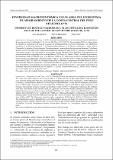Por favor, use este identificador para citar o enlazar este ítem:
https://hdl.handle.net/20.500.12958/7765| Título : | Diversidad macrobentónica en un área del ecosistema de afloramiento de la costa central de Perú (Huacho, 11°S) |
| Otros títulos : | Diversity of benthic macrofauna in an upwelling ecosystem area of the central coast of Perú (Huacho, 11°S) |
| Autor : | Quipúzcoa, Luis Marquina, Robert Tam, Jorge |
| Palabras clave : | Diversidad bentónica;Disóxico;Costa Central del Perú |
| Fecha de publicación : | jun-2023 |
| Editorial : | Instituto del Mar del Perú |
| Citación : | Quipúzcoa, L., Marquina, R. y Tam, J. (2023). Diversidad macrobentónica en un área del ecosistema de afloramiento de la costa central de Perú (Huacho, 11°S). Inf Inst Mar Perú, 50(2), 259-276. |
| Citación : | Informe IMARPE 50(2), 2023; |
| Resumen : | En noviembre 2018, en el área piloto de Huacho se encontraron 28 taxa de los cuales 20 correspondieron a la Clase Polychaeta, 1 al Subphylum Crustacea, 2 al Phylum Mollusca, 1 al Phylum Echinodermata, 1 al Phylum Nemertea, y entre otros a Phoronida, Actiniaria y Enteropneusta. Porcentualmente, tanto en abundancia como en biomasa, Polychaeta alcanzó el 70 %. El número de especies encontrado fue menor a 15 spp. 0,075 m-2, con mayor riqueza en la zona norte cercana a isla Don Martín y al sur frente a Punta San Juan, Playa Arenilla y Playa Herradura. La mayor densidad fue registrada en la estación E44 con 23 270 ind. m-2, frente a Playa la Arenilla. En promedio, las estaciones E44 con 122,951 g m-2 y la E62 con 77,800 g m-2 obtuvieron la mayor biomasa húmeda. El
índice de riqueza de Margalef varió entre 0,000 y 1,526 y la equidad de Pielou al norte de Huacho estuvieron entre 0,485 y 0,827. El índice de diversidad específica de Shannon, comprendió de 0,086 bits/ind. (E47) a 2,913 bits/ind (E43). El análisis de clasificación identificó dos grupos bien diferenciados, uno grande (G1) muy homogéneo caracterizado por Magelona phyllisae y Hermundura fauveli; y otro grupo (G2) menor en cobertura espacial caracterizado por M. phyllisae, H. fauveli, Paraprionospio pinnata, Owenia collaris, Phoronis sp., Leitoscoloplos chilensis y Sigambra bassi. ABSTRACT: In November 2018, a total of 28 taxa were found in the Huacho Pilot Area, including 20 corresponding to the Class Polychaeta, 1 to the Subphylum Crustacea, 2 to the Phylum Mollusca, 1 to the Phylum Echinodermata, 1 to the Phylum Nemertea, and others such as Phoronida, Actiniaria, and Enteropneusta. Polychaeta represented 70% of both abundance and biomass. The number of species found was less than 15 spp. 0.075 m-2, with greater richness in the northern zone near Don Martín Island and the south, off Cape San Juan and the beaches Arenilla and Herradura. The highest density was recorded at station E44 with 23,270 ind. m-2, off the coast of Arenilla Beach. On average, stations E44 with 122.951 g m-2 and E62 with 77.800 g m-2 obtained the highest wet biomass. The Margalef’s richness index varied between 0.000 and 1.526 and the Pielou’s evenness index north of Huacho fluctuated from 0.485 to 0.827. The Shannon’s diversity index ranged from 0.086 bits/ind. (E47) to 2.913 bits/ind (E43). The classification analysis identified two well-differentiated groups, one large (G1) and very homogeneous characterized by Magelona phyllisae and Hermundura fauveli, and another smaller group (G2) characterized by M. phyllisae, H. fauveli, Paraprionospio pinnata, Owenia collaris, Phoronis sp., Leitoscoloplos chilensis, and Sigambra bassi. |
| URI : | https://hdl.handle.net/20.500.12958/7765 |
| ISSN : | 0378-7702 |
| Aparece en las colecciones: | Informe vol. 50(2) 2023 |
Ficheros en este ítem:
| Fichero | Descripción | Tamaño | Formato | |
|---|---|---|---|---|
| Informe 50(2) Articulo 12.pdf | 1,08 MB | Adobe PDF |  Visualizar/Abrir |
Este ítem está sujeto a una licencia Creative Commons Licencia Creative Commons

